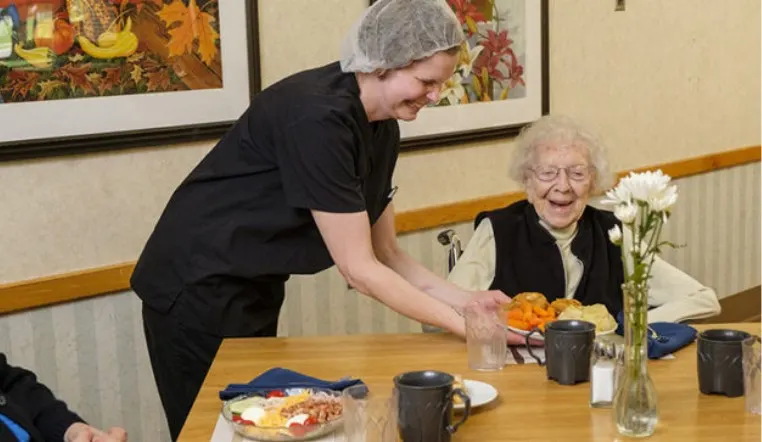Dear Katrina,
I’ve been helping my dad look into assisted living communities. I know this might not seem like a big deal, but one of his main concerns is what the food will be like.
He’s worried that if he moves, he’ll be stuck eating boring, bland food every day. He’s also a pretty independent person and doesn’t like the idea of being told what and when to eat.
Can you help us get a better idea of what the food is like in assisted living? Also, what does it cost?
Sincerely,
Corrine L.
The Dining Experience at an Assisted Living Community
Dear Corrine,
It’s a perfectly valid concern—and one that many seniors share before moving into an assisted living community. I will say, most if not all of them are pleasantly surprised at how good the food is when they do.
To help your father feel more comfortable about the possibility of moving into a community, here’s what he can expect when it comes to dining.
Is Food Included in the Cost of Assisted Living?
Food is included in the monthly cost of most assisted living communities. Different communities offer different amenities and services as a part of their monthly rates, but dining is usually covered with that cost.
At Cranberry Park, residents receive three meals daily and snacks. Guests are also welcome to dine with residents. Guest meals are available daily and can be ordered by contacting the receptionist at the community.
________________________________
Related: Convincing Mom or Dad that It’s Time
________________________________
How Is the Food in Assisted Living?
Nutrition is key for any diet but especially so for seniors.
In 2016, nutrition scientists at Tufts University, with support from AARP Foundation, introduced an updated food pyramid for seniors. To best meet their nutritional needs, seniors are encouraged to structure their diet around these guidelines:
- 50 percent fruits and vegetables
- 25 percent grains (whole grains are ideal)
- 25 percent protein-rich foods (such as nuts, beans, fish, lean meat, poultry and fat-free and low-fat dairy products such as milk, cheeses and yogurts)
Included in the new recommendations is an emphasis on healthy fluids. Liquids such as water, milk, tea, soup or coffee are a great way to maintain an appropriate fluid intake.
Now, the question on many seniors’ minds (including your father’s) is: “Will the food be good, or will it be boring and tasteless?”
Many seniors assume that healthy eating at a senior living facility equals bland, boring food. Not so.
In a healthy diet, there’s room for fats such as vegetable oils and soft margarines, which are heart-healthy. Overconsumption of salt should be avoided, especially for people over 50, but herbs and spices are healthy, tasty alternatives that make food flavorful and delicious.
At MacIntosh, selection and enjoyment are just as important as nutrition. Our dining service teams plan seasonal menus and offer a variety of foods. Residents can enjoy numerous side dishes, ethnic favorite and homemade classics.
________________________________
Related: Ask the Expert: How’s the Food in Rehab?
________________________________
Sample Assisted Living Dining Menus
To give you an idea of what is served, the seasonal food menus at our assisted living communities include dishes such as savory roasted chicken, hearty vegetable soup, beer-battered fish, braised Swiss steak and herbed pork loin.
Special dietary restrictions are also taken into consideration. Registered and licensed dietitians work with dietary services managers such as myself to provide food choices tailored to any diet restrictions residents may have.
While the dietitians make recommendations based on their expert opinion, residents are not left without a say. Each diet is set with the resident and his or her choices are taken into account.
This is important to note because many seniors assume that moving to assisted living represents a loss of independence, but this is not the case.
Residents in assisted living receive access to services and amenities, but they are still independent. They get to make their own choices about what they do from day to day, and that includes dining decisions.
I hope this helps! Please contact us if you have any further questions about assisted living.
Katrina Self
Dietary Services Manager


